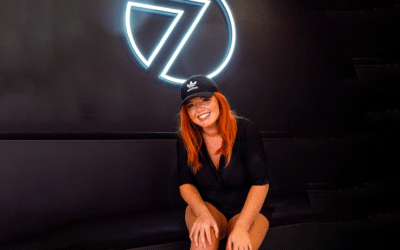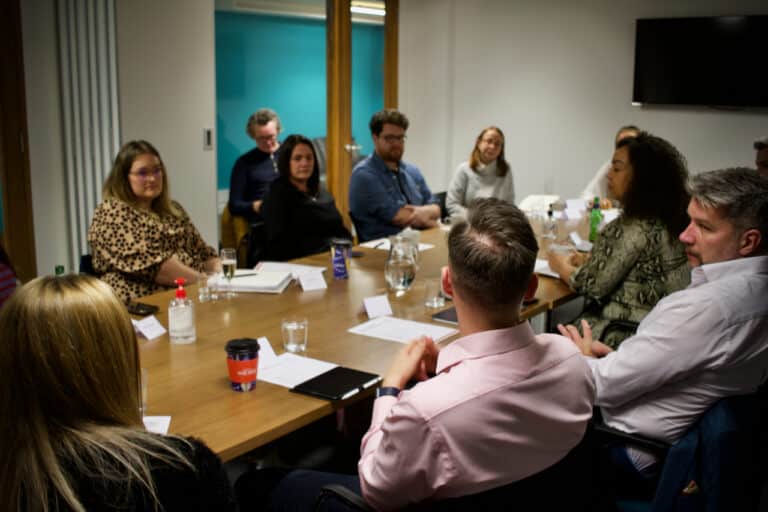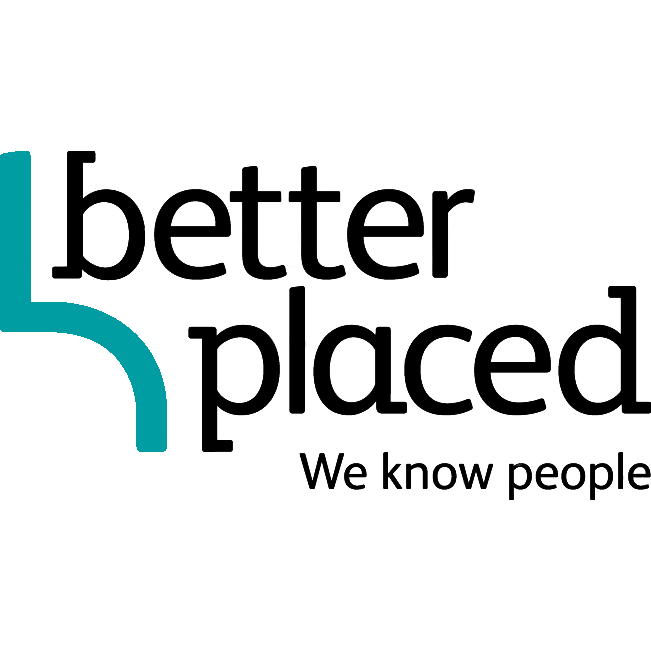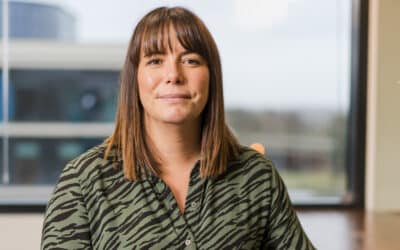Attendees:
- Rebecca Taylor, Programme Leader & Academic Lead, Hyper Island
- Ollie Purdom, Chief Talent Officer, McCann
- JP Atley, Head of Marketing Services, Circulate Digital
- Rob Shaw, CEO, CreativeRace
- Sally Stevens, Founder and Director, Sally Stevens Consulting
- Leanne Taylor, Finance & HR Director, connective3
- Andy Cooke, Recruitment Manager, Tes Global
- Rick Ward, Creative Director, We are the Allies
- Sarah Speechly, Group Head of People, Audience Collective
- Clair Heaviside, Co-founder, Serotonin
- Mark Hadfield, Strategy Partner, Cravens
- Alison Livesey, Director, Better Placed
- Zoe Wallace, Director, Agent Academy
Acquisition
Rosie MacPhail (Better Placed) opened the conversation with a question to the guests on why they thought the greatest struggle for most at the moment seemed to be within the acquisition of junior talent.
Zoe Wallace (Agent Academy) said there’s no single reason, but there’s definitely a communication barrier between employers and talent. Once junior talent is in, they fly – but employers are failing to communicate properly what the opportunities are for young people.
There’s a disconnect, said Clair Heaviside (Serotonin), between young people in education and employers’ expectations of what they’ll be capable of.
Some of that is on the agency sector, said Ollie Purdom (McCann). There’s a preconception of what an ‘agency person’ looks like – they’re degree-educated and have work experience – but that’s myopic. McCann has used the Kickstart scheme as a test-bed, and shown that what matters more than the CV is attitude and aptitude.
Mark Hadfield (Cravens) said that the challenge also lies within defining the industry. The range of roles is huge, and while looking for very different people, companies are going to exactly the same pools of talent.
It’s far from exclusive to marketing, responded Andy Cooke (Tes Global) – take software engineers and developers. They’re incredibly hard to get hold of, caused in part by the digital industry being selective about what it wants. What’s needed is a reevaluation of where talent arises – for employers to work more closely with education providers.
Agility of education is a major issue, said Rebecca Taylor (Hyper Island). The education sector is now focusing on what it has to offer.
What do attitude and aptitude look like? Ollie (McCann) said it’s intangible – passion and enthusiasm that can’t be put across in a CV or learned on work experience. The Kickstart talent is throwing themselves into it, and the leadership team is now keen to hire them.
Retention
The conversation turned to onboarding of staff members. It’s a huge challenge in a hybrid world, said Ollie (McCann), and for their Kickstart talent they have to make sure they’re in the office regularly, supported by people around them.
Tes Global has an inbuilt onboarding process enabled through its HR system, said Andy. Onboarding isn’t from day one, he said – it’s from the point of acceptance up to the first day, and beyond into month three.
Rob Shaw (CreativeRace) said their onboarding process has been classed as at the point brief is handed to recruiter. They’re articulating the agency’s proposition to the candidate so it’s necessary to remove any points of friction. CreativeRace has identified any point an ideal candidate might not come to them, and made the whole thing comfortable.
Who’s representing your business around the table, asked Zoe (Agent Academy). It must be considered or it can put off the kind of person you’re trying to attract. It’s about bringing in people at interview stage who could be mentors and supporters.
When it comes to Diversity & Inclusion, Alison Livesey (Better Placed) said they now have clearer policies on D&I and make sure they ask clients their policy for every recruitment brief they take. It’s alarming how many of them don’t know. And if a company can’t show D&I to a candidate it has to directly make that commitment with them.
CreativeRace has just updated its D&I policy, said Rob Shaw. Originally they were doing it as a leadership team, but have turned it upside down. The best people who can contribute to the agency’s D&I policy is the wider business, so they now have a cross-functional group contributing, where everyone has an equal opinion, not influenced by seniority.
Andy (Tes Global) added that they’re helping one of their clients FuturePlus, part of The Sustainability Group, release a tool aligning the UN sustainability goals to businesses, and using it themselves as a benchmark for internal success.
Zoe (Agent Academy) said it’s about making a policy come to life. Agent itself has its EDIE (Equality, Diversity and Inclusion for Everyone) group, whose members are changing all the time as the business changes. A recent neurodivergent hire joined the EDIE group which was great as they previously didn’t have people on the autistic spectrum represented.
It’s always better to go bottom-up rather than top-down, said Sarah Speechly (Audience Collective). Often the people making the decisions haven’t faced inclusivity problems – but everyone knows how it feels to be excluded. She’s recently launched a colleague engagement forum which helps people lower down in the organisation tell leadership what’s needed.
Andy (Tes Global) said that BT, who he worked for previously, introduced a ‘reverse mentorship’ scheme partnering senior leaders with more junior people to take them through D&I topics. It displayed the organisation’s commitment to listening and making change.
Businesses have to be clear on what success is, added Mark (Cravens). We need to be accountable with ourselves about what the outcomes we want are.
Zoe (Agent Academy) said creating a representative workforce works so well because you improve your organisation overall. Regardless of the end goal, success is if you’ve got a range of people applying because they know you care. It’s about opening up a wider funnel of talent, agreed Andy (Tes Global).
Rebecca (Hyper Island) said that perhaps a radical step needs taking. Businesses are failing to be purpose-driven so the strategy might be to admit to their faults up-front with candidates, and commit to change to retain talent.
Have the attendees improved their overall work-life balance as a result of COVID, asked Rosie (Better Placed).
Freelancers have been helped, said Rick Ward (We are the Allies) – territories have opened up for them, and their talents can be shared more widely.
The reliance on freelance talent is exacerbated by the current hiring challenges but there’s always space for them, said Rob (CreativeRace). It helps tell clients they can move on projects rapidly, and gives you access to expertise.
Perception of freelance work has changed too, said Zoe (Agent Academy). Use has increased because work demands it, clearly, but now ways of working have changed the cultural fit between staff and freelancers doesn’t feel as different.
Engagement
What are companies’ hybrid working policies, asked Rosie (Better Placed) – now candidates are beginning to be more selective around how their work week looks, and won’t necessarily accept five days on-site.
Leanne Taylor (connective3) said their C-suite comes to the office three days a week, while everyone else is in for two, which gives employees flexibility to get support when they need.
Serotonin is quite different to others, said Clair – they’re back in the office five full days and have been since March, with flexibility built in. The young team wants to come together and the collaborative nature is necessary in a smaller agency like theirs.
It’s about being honest about who you are as a company, said Ollie (McCann). And it depends on life stage – younger employees with less space and different lifestyles often want to be in more.
Give people a reason to come back, said Andy (Tes Global), things like collaborative spaces and social events. Recently someone within the team got an internal promotion based on an off-the-cuff conversation over a drink in the office.
Rebecca (Hyper Island) said we’ve missed serendipity. There are loads of reasons to want to get back together again.
A danger that hasn’t been seen yet, said Rob (CreativeRace), is that of a twin-track culture where those who do attend the office get promotions. It may go further, said Mark (Cravens) – especially within agency networks there will be pressure on junior staff to show their face, and promotions and pay rises may lead to legal ramifications as a result.
JP Atley (Circulate Digital) said willingness to work from home depends on home setup. When Circulate recently had to return home again for an office move, some of the team hated it.
We have to be mindful, agreed Rob (CreativeRace). When their IT Director was offering improved monitors to designers at the agency, the question had to be “can they actually have one at home?” Not if they’re at their parents’ dining table, for example. That conversation must be normalised.
Mark (Cravens) said another problem faced was that on the days he wanted to go in and be collaborative, the people he wanted to be collaborative with weren’t there. How do you align people and places?
It comes down to management and support, said Zoe (Agent Academy). She said she is challenged when really junior talent works from home because it’s hard to support those who get lost. Are people supported to succeed?
Sally Stevens (Sally Stevens Consulting) said her observation was the gap between what people are expected to do and what they know how to do. They’re not taught to write a contact report or conduct a meeting, for example. Regardless of where you can work from, the question should be how people are helped to work, succeed and flourish.
Tes Global regularly conducts an anonymous survey with its whole workforce to check in, said Andy. All managers within the company can see it, when enough have completed it to ensure anonymity. You can check engagement levels, see where it’s dipping, and forecast attrition.
Rebecca (Hyper Island) said engagement is a two-way street, not checking in to find out if staff are performing.
Churn isn’t necessarily bad when managed right, said Mark (Cravens). Some of the best people he’s worked with were only around two years – instead, it’s about keeping the right people and getting fresh energy.
Focusing on collaboration, Ollie (McCann) said people are realising their duty of care to the industry which has lost good people. The sector is more honest with where it is.



























